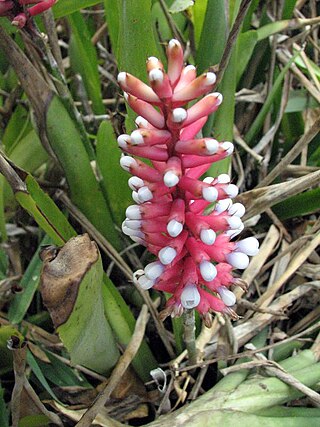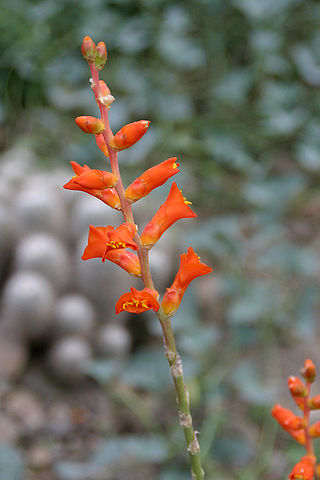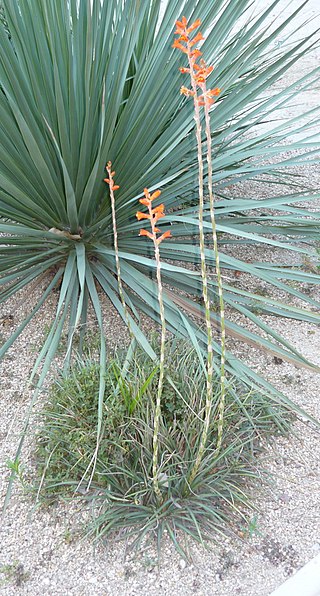
Aechmea bromeliifolia is a bromeliad native to southern Mexico, Central America, Trinidad, and South America as far south as northern Argentina.

Aechmea cylindrata is a bromeliad, native to southeastern Brazil from São Paulo to Santa Catarina. This plant is cited in Flora Brasiliensis by Carl Friedrich Philipp von Martius, and it is often used as an ornamental plant.

Aechmea gamosepala is a bromeliad endemic to southern Brazil. It is often cultivated as an ornamental plant. This plant is cited in Flora Brasiliensis by Carl Friedrich Philipp von Martius

Aechmea nudicaulis is a bromeliad species in the genus Aechmea, which is often used as an ornamental plant. This species is native to Central America, the West Indies, central and southern Mexico, and northern and central South America.

Billbergia nutans, or Queen's-tears, is an epiphytic bromeliad native to Brazil, Paraguay, Uruguay, and Argentina.

Billbergia pyramidalis, commonly known as the flaming torch and foolproof plant, is a species of bromeliad that is native to northern South America and parts of the Caribbean. It was first described by John Sims, and got its current name by John Lindley.

Hohenbergia stellata is a perennial species of the genus Hohenbergia. It is native to Trinidad and Tobago, Martinique, Netherlands Antilles, Venezuela, and northeastern Brazil.

Aechmea coelestis is a species of flowering plant in the genus Aechmea. This is a species that is native to southeastern Brazil from Espírito Santo to Santa Catarina.

Dyckia leptostachya is a plant species in the genus Dyckia. This species is native to Brazil, Bolivia, Paraguay, and Argentina.

Aechmea aquilega is a plant species in the genus Aechmea. This species is native to Brazil, Venezuela, the Guianas, Trinidad, Jamaica and Costa Rica.
Aechmea bocainensis is a species of plant in the genus Aechmea. This species is endemic to Brazil, found in the States of Rio de Janeiro and São Paulo.

Aechmea emmerichiae is a species of flowering plant in the genus Aechmea. This species is endemic to Chapada Diamantina National Park in eastern Brazil.
Aechmea organensis is a plant species in the genus Aechmea. This species is endemic to southeastern Brazil.

Aechmea caudata is a species in the genus Aechmea. This species is native to southeastern Brazil from Espírito Santo to Rio Grande do Sul.

Aechmea recurvata is a plant species in the genus Aechmea. This species is native to southern Brazil, Paraguay, Uruguay and northern Argentina.

Tillandsia geminiflora is a species in the genus Tillandsia. This species is native to Brazil, Suriname, Paraguay, Uruguay, and the Misiones Province of Argentina.

Aechmea setigera is a plant species in the genus Aechmea. This species is native to Bolivia, Venezuela, Colombia, Panama, Suriname, French Guiana, Ecuador, and northern Brazil.

Aechmea lingulata is a plant species in the genus Aechmea. This species is native to the West Indies, Costa Rica, Panama and northern South America.

Dyckia rariflora is a plant species in the genus Dyckia endemic to the State of Minas Gerais in Brazil.

Dyckia remotiflora is a plant species in the genus Dyckia. It is native to Argentina, Uruguay, and Brazil.




















